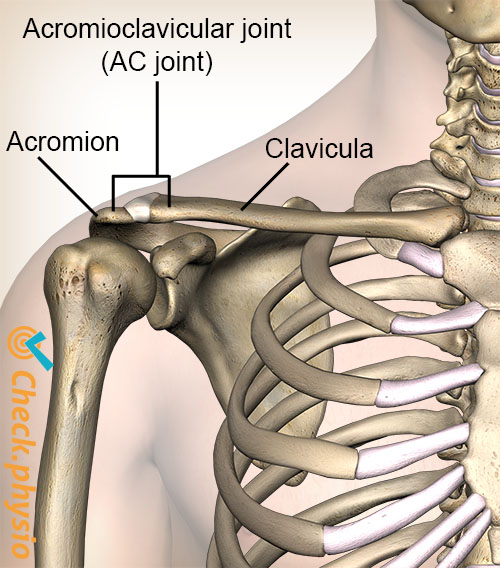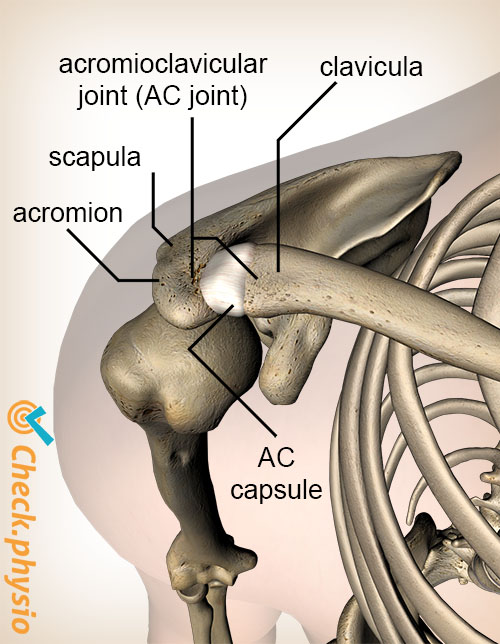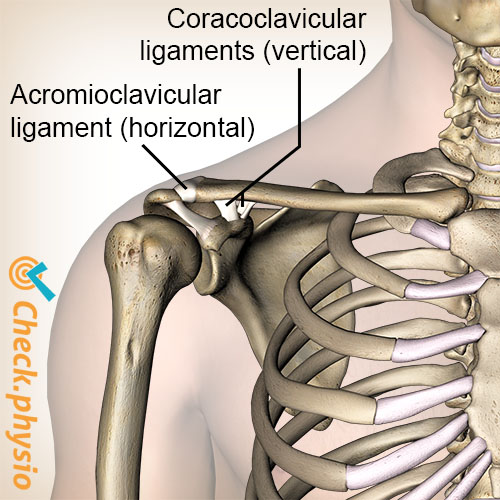- Conditions
- Acromioclavicular injury
Acromioclavicular injury AC joint (sub)luxation
Introduction
The acromioclavicular joint, also called the 'AC joint', forms the connection between the clavicle (collarbone) and the top of the shoulder blade. Dislocation of this joint can cause damage to the ligaments and capsules that stabilise the joint.
Injuries to the AC joint are common in cyclists and judokas. They are at increased risk of falling on the top of the shoulder. This is a classic cause of acromioclavicular dislocation (luxation).

Description of the condition
The clavicle is connected to the acromion via the AC joint. This is the top and outermost part of the shoulder blade. The joint is kept in position by ligaments. If these ligaments become damaged, this can result in acromioclavicular symptoms.
When the forces on the AC joint become too great, for example through an accident or a fall, this can cause ligament rupture. The clavicle is effectively dislocated.
Cause and origin
The injury is usually caused by a fall on the top of the shoulder or on an outstretched arm. This causes bruising of the surrounding tissues.
Signs & symptoms
The painful spot can often be pinpointed. Sometimes the symptoms can be provoked by pressing on or around the AC joint. The pain increases when the shoulder is moved forward, or when the shoulder hangs down. There can also be swelling.
As the AC joint is located directly beneath the skin, it is often clear in the case of a severe injury that the clavicle is not in the correct position. The clavicle juts upwards slightly and a clear 'step' is visible on the shoulder. Always compare the right and left shoulders in order to assess any abnormality.
Diagnosis
The diagnosis is made according to the patient's story and a number of physiotherapeutic tests. Often the passive movement of the upper arm in front of the body towards the chest (horizontal adduction) is painful.
Treatment and recovery
Treatment depends on the type of injury. Types I and II are always treated without surgery. Type IV to VI do require surgery. The treatment of type III is less clear. Physiotherapy treatment is often the treatment that is started. If the result is not satisfactory, surgery will be performed after all.
Rest, icing and a sling
Type I, II and III treatment initially consists of rest and icing. Rest is given by using a sling. For type I, the use of a sling for a few days is usually sufficient. For type II and III, it may be necessary to put the arm in a sling for 6 weeks.
Physiotherapy
With regard to type I, it is possible to have the arm treated immediately by a physiotherapist. Strength exercises can start after a few days. Once full mobility and strength have been regained, all activities can be resumed.
With regard to type II and III, physiotherapy can start after 14 to 21 days. In case of a serious displacement of the collarbone, treatment can only start after 6 weeks. Tape can give the AC-joint extra rest if necessary. The ligaments will be fully restored after 8 to 12 weeks. Heavy lifting or exercising is only allowed after that period of time. Also this is only allowed if the shoulder can move completely without pain.
Surgery
In surgery the AC joint will be brought back into the correct position and fixed. An artificial ligament is often used in this process by attaching it to the shoulder blade via the collarbone. It keeps the collarbone in the right place again.
After surgery, the arm will have to be kept in a sling for 6 weeks. Physiotherapy treatment can start immediately. Complete recovery after surgery takes six months.
Exercises
Take a look at the exercise programme with exercises for injury of the AC joint.
More info
You can check your symptoms using the online physiotherapy check or make an appointment with a physiotherapy practice in your area.
References
Nugteren, K. van & Winkel, D. (2007) Onderzoek en behandeling van de schouder Houten: Bohn Stafleu van Loghum.
Schünke, M., Schulte, E. & Schumacher, U. (2005) Prometheus. Algemene anatomie en bewegingsapparaat Houten: Bohn Stafleu Van Loghum.
Moen, M.H., Vos, R-J. de, Arkel, E.R.A. van, Weir, A., Moussavi, J., Kraan, T. & Winter, Th.C. de (2008) De meest waardevolle klinische schoudertesten Sport & Geneeskunde. 2008;4:6-19.


